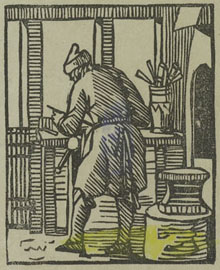Catchpenny prints of the Koninklijke Bibliotheek > What are catchpenny prints?
Catchpenny prints reported – for one or a few pennies - in word and image on important events, such as catastrophes, crimes and battles. Prints depicting the lives of saints or Biblical scenes manifested devotion and religious convictions. Quack doctors, old spinsters, henpecked husbands and victims of swindle were ridiculed. Fantasies came to life in prints featuring themes such as the land of Cockaigne and fairy tales.
Catchpenny prints were printed on cheap paper of a slightly larger size than the present A3-format and contain one or more illustrations, generally accompanied by a brief text. The catchpenny prints were often sloppily coloured and they were especially geared to a public with little purchasing power. In the past they have also been called children’s prints, popular prints, ‘oortjes’ prints (in Dutch money, an oortje was a cent and a quarter), saints or ‘mannekesblaren’ (in Dutch: little fellows’ leaves). The term ‘catchpenny prints’ emphasizes an economic aspect: for a long time catchpenny prints were the cheapest illustrated printed material in the Netherlands.

